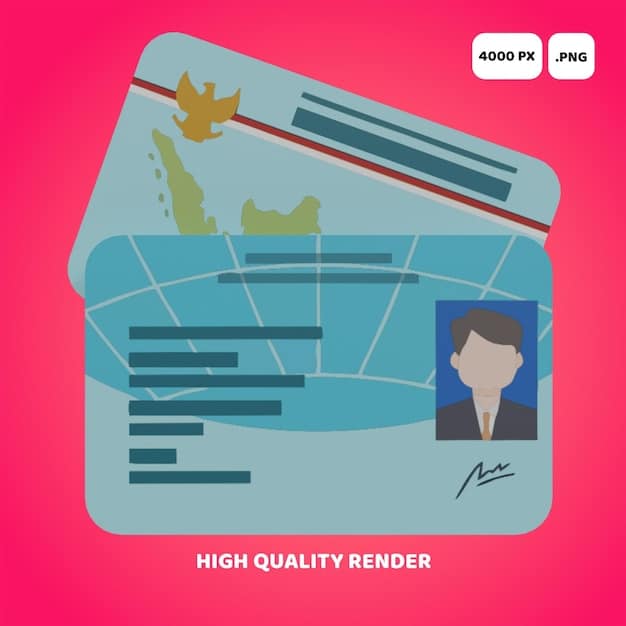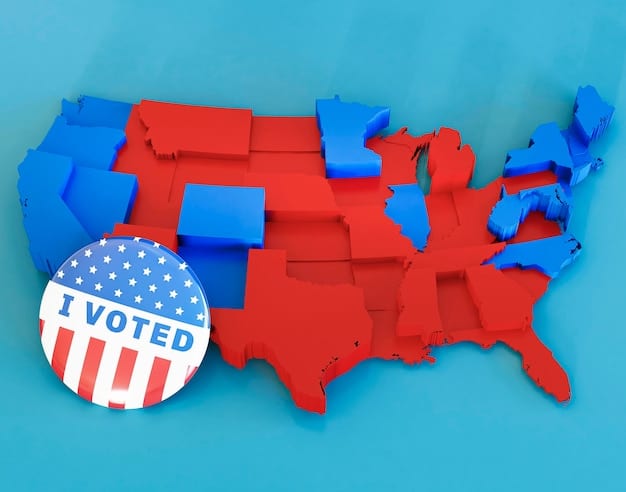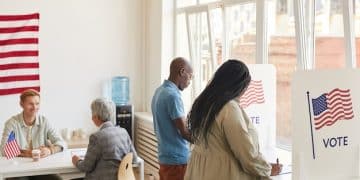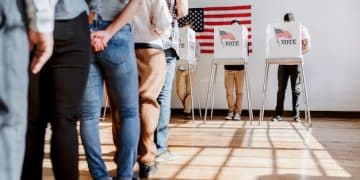The Impact of Voter ID Laws on Minority Turnout in the 2024 Election

Understanding the Impact of Voter ID Laws on Minority Voter Turnout in the 2024 Election reveals a complex interplay between legal requirements, historical inequalities, and the exercise of democratic rights, highlighting concerns about disproportionate effects on minority communities.
The Understanding the Impact of Voter ID Laws on Minority Voter Turnout in the 2024 Election is crucial for ensuring fair and equal access to the ballot box for all citizens. These laws, requiring voters to present identification at the polls, have become a contentious issue, raising concerns about potential discriminatory effects, particularly on minority communities.
Voter ID Laws: A Contentious Debate
Voter ID laws have sparked a nationwide debate, with proponents arguing they are essential for preventing voter fraud and ensuring election integrity. Opponents contend that these laws disproportionately burden minority voters, creating barriers to participation and suppressing turnout. The core of the debate lies in balancing the need for secure elections with the fundamental right to vote.
The Argument for Voter ID Laws
Supporters of voter ID laws emphasize the importance of preventing voter impersonation and maintaining public confidence in the electoral process. They argue that requiring voters to present identification is a commonsense measure that helps safeguard against fraud and ensures that only eligible voters cast ballots. This position often aligns with concerns about the integrity of elections and the need for stricter regulations.
The Argument Against Voter ID Laws
Critics argue that voter ID laws disproportionately impact minority voters, particularly those who may have limited access to required identification. These voters may face challenges in obtaining the necessary documents due to factors such as poverty, lack of transportation, or limited access to government services. Opponents contend that these laws are a form of voter suppression, designed to disenfranchise minority communities and reduce their political influence.

Recent studies have shed light on the impact of voter ID laws on minority turnout, revealing a complex picture with varying effects across different states and demographic groups. Some studies have found a significant decrease in turnout among minority voters in states with strict ID requirements, while others have shown little or no impact.
- The Brennan Center for Justice has published numerous reports documenting the discriminatory effects of voter ID laws on minority communities.
- Academic research has examined the relationship between voter ID laws and minority turnout rates, providing empirical evidence on the issue.
- Advocacy groups such as the ACLU and the NAACP have challenged voter ID laws in court, arguing that they violate the Voting Rights Act and the Fourteenth Amendment.
The debate over voter ID laws remains highly polarized, with both sides presenting compelling arguments backed by research and legal analysis. As the issue continues to be debated in state legislatures and federal courts, it is essential to consider the potential impact on minority voter turnout and the broader implications for democratic participation.
The Landscape of Voter ID Laws in the US
The United States has a diverse landscape of voter ID laws, with each state having its own set of regulations. Some states have strict photo ID requirements, while others allow voters to use non-photo identification or sign an affidavit if they do not have the required ID. Understanding these variations is crucial for evaluating the impact of voter ID laws on minority turnout.
Strict Photo ID States
States with strict photo ID laws require voters to present a valid government-issued photo identification at the polls. Acceptable forms of identification typically include driver’s licenses, passports, and military IDs. These states often have limited exceptions for voters who do not have the required ID, making it more difficult for them to cast a ballot.
Non-Photo ID States
In contrast, states with non-photo ID laws allow voters to present a wider range of identification documents, including utility bills, bank statements, and government-issued documents without a photo. These states often have more flexible requirements, making it easier for voters to comply with the law and cast a ballot.

The impact of voter ID laws on minority turnout varies depending on the specific requirements in each state. Studies have shown that strict photo ID laws have a greater negative impact on minority turnout compared to non-photo ID laws. This is likely due to the fact that minority voters are less likely to have access to government-issued photo identification, making it more difficult for them to comply with the law.
- The National Conference of State Legislatures provides up-to-date information on voter ID laws in each state.
- The Voting Rights Act of 1965 prohibits states from enacting voter ID laws that discriminate against minority voters.
- The Help America Vote Act of 2002 requires states to implement certain voter ID requirements for first-time voters who register by mail.
As state legislatures continue to debate voter ID laws, it is essential to consider the potential impact on minority turnout and the broader implications for democratic participation. A nuanced understanding of the diverse landscape of voter ID laws in the US is crucial for ensuring fair and equal access to the ballot box for all citizens.
Demographic Disparities in ID Access
Significant demographic disparities in access to required identification exist throughout the US. Minority communities, particularly those with low incomes, face unique challenges in obtaining the necessary documents due to various factors such as poverty, lack of transportation, and limited access to government services. Understanding these disparities is crucial for evaluating the impact of voter ID laws on minority turnout.
Poverty and ID Access
Poverty can create significant barriers to obtaining required identification. Low-income individuals may struggle to afford the fees associated with obtaining a driver’s license or passport. They may also lack access to transportation to travel to government offices or the necessary documents to prove their identity and residency. These challenges can make it more difficult for low-income individuals to comply with voter ID laws and cast a ballot.
Transportation and ID Access
Lack of transportation can also pose a significant barrier to obtaining required identification. Many government offices are located in urban areas, making it difficult for individuals in rural areas to access these services. Minority communities in rural areas may face additional challenges due to limited public transportation options and reliance on personal vehicles.
Access to Government Services
Limited access to government services can also hinder minority voters from obtaining required identification. Government offices may have limited hours or be located far from minority communities, making it difficult for individuals to access these services. Language barriers can also be a challenge for minority voters who may not be fluent in English.
Addressing demographic disparities in ID access is essential for ensuring fair and equal access to the ballot box for all citizens. Policymakers should consider implementing measures such as providing free or reduced-cost identification, establishing mobile ID units in underserved communities, and expanding access to government services in minority communities. These steps can help reduce barriers to participation and ensure that all eligible voters have the opportunity to cast a ballot.
Legal Challenges to Voter ID Laws
Voter ID laws have faced numerous legal challenges, with opponents arguing that they violate the Voting Rights Act and the Fourteenth Amendment of the US Constitution. These lawsuits have raised important questions about the constitutionality and discriminatory effects of voter ID laws, leading to significant legal battles in state and federal courts.
Voting Rights Act Challenges
The Voting Rights Act of 1965 prohibits states from enacting voter ID laws that discriminate against minority voters. Opponents of voter ID laws have argued that these laws have a disparate impact on minority communities, violating Section 2 of the Voting Rights Act. These lawsuits often rely on statistical evidence and expert testimony to demonstrate the discriminatory effects of voter ID laws.
Fourteenth Amendment Challenges
The Fourteenth Amendment guarantees equal protection under the law. Opponents of voter ID laws have argued that these laws violate the Fourteenth Amendment by creating unreasonable burdens on the right to vote. These lawsuits often focus on the accessibility of required identification and the potential for voter disenfranchisement.
Notable Court Cases
Several notable court cases have challenged the constitutionality of voter ID laws. These cases have provided important legal precedents and shaped the legal landscape of voter ID laws in the US.
- Shelby County v. Holder (2013): The Supreme Court struck down Section 5 of the Voting Rights Act, which required certain states with a history of discrimination to obtain federal approval before changing their voting laws. This decision has made it more difficult to challenge voter ID laws in court.
- Veasey v. Perry (2014): A federal court struck down Texas’s strict photo ID law, ruling that it violated the Voting Rights Act and the Fourteenth Amendment. The court found that the law had a discriminatory effect on minority voters.
- Frank v. Walker (2014): The Supreme Court upheld Indiana’s strict photo ID law, ruling that it did not violate the Constitution. The court found that the state had a legitimate interest in preventing voter fraud.
The legal challenges to voter ID laws continue to be litigated in state and federal courts. As these cases progress, they will likely shape the future of voter ID laws in the US and have a significant impact on minority voter turnout.
The Impact on Minority Voter Turnout in 2024 Election
The 2024 election served as a crucial test for understanding the real-world impact of voter ID laws on minority voter turnout. With varying regulations across states and continued legal challenges, the election provided valuable insights into the effects of these laws on democratic participation. Understanding these effects is essential for promoting fair and accessible elections for all citizens.
Early Voting Trends
Early voting trends in the 2024 election revealed potential disparities in turnout rates among minority voters. In states with strict photo ID laws, early voting turnout among minority voters may have been lower compared to states with more flexible ID requirements. These trends highlight the potential barriers that voter ID laws can create for minority communities.
Election Day Turnout
Election day turnout data also provided valuable insights into the impact of voter ID laws on minority voter turnout. In some states, minority voters may have faced challenges at the polls due to ID requirements, leading to longer wait times or difficulty casting a ballot. These challenges can discourage participation and reduce overall turnout rates.
Post-Election Analysis
Post-election analysis of voter turnout data is essential for understanding the actual impact of voter ID laws on minority communities. Researchers and advocacy groups often conduct studies to examine turnout rates among different demographic groups and assess the effects of voter ID laws on participation. These analyses can provide valuable evidence for policymakers and legal challenges to voter ID laws.
Several factors can influence minority voter turnout, including voter ID laws, registration requirements, and demographic trends.
- The impact of voter ID laws on minority turnout may vary depending on the specific requirements in each state.
- Voter registration deadlines and requirements can also affect minority turnout rates.
- Demographic trends, such as population growth and shifts in party affiliation, can influence voter turnout among minority communities.
The 2024 election provided valuable insights into the impact of voter ID laws on minority voter turnout. By analyzing early voting trends, election day turnout data, and post-election data, we can gain a better understanding of the effects of these laws on democratic participation and work toward ensuring fair and accessible elections for all citizens.
Alternatives to Strict Voter ID Laws
To balance the need for secure elections with the fundamental right to vote, several alternatives to strict voter ID laws exist. These alternatives aim to address concerns about voter fraud while minimizing the burden on minority voters and ensuring equal access to the ballot box. Exploring these alternatives is crucial for creating fair and inclusive election systems.
Same-Day Voter Registration
Same-day voter registration allows voters to register and cast a ballot on the same day, reducing barriers to participation and increasing turnout. This policy can particularly benefit minority voters who may have moved recently or face other challenges in registering to vote. States with same-day voter registration have generally seen higher turnout rates compared to states with strict registration deadlines.
Expanded Early Voting Opportunities
Expanding early voting opportunities, such as increasing the number of early voting locations and extending the early voting period, can also reduce barriers to participation. Early voting allows voters to cast a ballot at their convenience, reducing wait times and making it easier for minority voters to comply with voter ID requirements.
Automatic Voter Registration
Automatic voter registration automatically registers eligible citizens to vote when they interact with government agencies, such as the DMV. This policy can significantly increase voter registration rates and reduce disparities in voter turnout among different demographic groups.
Several strategies can minimize the impact of voter ID laws on minority voter turnout, including providing free or reduced-cost identification, establishing mobile ID units in underserved communities, and expanding access to government services in minority communities.
- Providing free or reduced-cost identification can help low-income individuals obtain the necessary documents to comply with voter ID laws.
- Establishing mobile ID units in underserved communities can bring government services directly to minority voters.
- Expanding access to government services in minority communities can address underlying barriers to ID access, such as poverty and lack of transportation.
By adopting these alternatives and implementing mitigation strategies, policymakers can create election systems that are both secure and accessible, ensuring that all eligible voters have the opportunity to cast a ballot.
| Key Point | Brief Description |
|---|---|
| 🔑 Voter ID Laws | Requirements for voters to present ID at the polls. |
| 🗳️ Minority Turnout | Concerns about disproportionate effects on minority voting. |
| ⚖️ Legal Challenges | Lawsuits claiming violation of Voting Rights Act. |
| 🛡️ Alternatives | Same-day registration, expanded early voting. |
Frequently Asked Questions
▼
Voter ID laws are regulations that require voters to show some form of identification before casting their vote. The types of accepted ID vary by state, from strict photo ID to non-photo options.
▼
They are controversial due to concerns about disproportionately affecting minority voters who may face barriers to obtaining required IDs, potentially disenfranchising them.
▼
The impact varied by state. Some saw reduced minority turnout, while others showed minimal change. Legal challenges and debates continue regarding their fairness and constitutionality.
▼
Alternatives include same-day voter registration, expanded early voting options, and automatic voter registration. These aim to increase participation while ensuring election integrity.
▼
Solutions involve providing free or reduced-cost IDs, establishing mobile ID units in underserved areas, and expanding access to government services for minority communities.
Conclusion
Understanding the impact of voter ID laws on minority voter turnout in the 2024 election is critical for ensuring democratic participation and equal access to the ballot box. By exploring the historical context, legal challenges, and potential alternatives, policymakers and citizens can work to create election systems that are both secure and inclusive.





